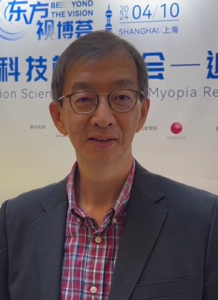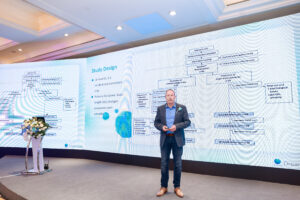April 15, 2024
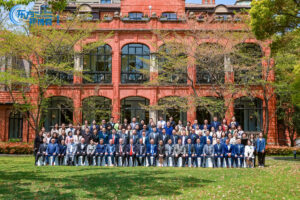
Attendees at “Frontier in Vision Science Summit – Myopia Research” in Shanghai came from China and from throughout the world. (Click to enlarge.)
SHANGHAI, China – The Asia Optometric Management Academy (AOMA) in partnership with Fudan University’s Eye and ENT Hospital in Shanghai, China, brought together leading researchers in the field of myopia for the “Frontier in Vision Science Summit – Myopia Research.” The event, held here April 10, 2024, explored the latest scientific research and future trends in myopia management.
Attended by about 100 of the leading ophthalmologists in China, “Frontier in Vision Science Summit — Myopia Research” delivered a full day of presentations from both domestic and international key opinion leaders from Europe, the U.S., and southeast Asia (listed below).
Leading local and international speakers in different disciplines in vision science and myopia research covered topics that included the epidemiology perspective on the global myopia burden, visual development, myopia defocus, molecular research in myopia, new technologies in myopia control, new insights into emmetropization and mechanism of myopia control, and AI-assisted myopia control innovations.
Hosts and Sponsors Bring the World of Myopia to China
The event’s lead sponsor was CooperVision. Other sponsors included Zeiss along with a number of Chinese companies looking to reach the domestic market.
The conference was organized and hosted by the Asia Optometric Management Academy (AOMA, pronounced Ō-mǝ), a non-profit organization that seeks to bring the eye care model developed in other Southeast Asian countries to China.
AOMA’s Tan Kah Ooi kicked off the conference with a bilingual welcome in both English and Chinese, thanking both AOMA and Fudan University for their sponsorship. “We are witnessing a lot of research and changes in myopia management, sharing across different parts of the world, hoping that we can foresee what will happen in the near future. Today we are fortunate to have distinguished speakers coming from industry and different areas of research, and hopefully by the end of the day we will be able to embark on a new journey of myopia research.” He was followed by another brief welcome by Prof. Zhou Xingtao of Fudan University, who later also presented in Chinese on the “Review and Outlook of 20 Years of Refractive Surgery in China.”
Manage the Myopia of Each Patient Individually
With shorter than a half hour for most speakers to present, often less, here are some highlights:
Leading off the presentations was Serge Resnikoff, chair of the International Myopia Institute, appearing virtually from France to establish the reasons for why myopia management with a discussion on the “Global Myopia Burden.” He said, “According to the most recent estimates, there are roughly three billion myopes in the world today. What this data shows us is that if nothing different is done, the number of people with myopia will reach the number of five billion people by 2050,” a statistic that has already been published extensively and was cited numerous times during the day’s conference. “The situation is different in the different regions, and it’s no surprise that the situation in Asia is the most severe by far. But what is even more concerning is that the number of people with high myopia is increasing, and this is primarily due to the increasing early onset of myopia. High myopia is a significant risk factor for many conditions such as retinal detachment and myopic maculopathy, but also for conditions such as cataract and glaucoma. But even moderate myopia is still a very important risk factor for all these conditions, and things like myopic macular degeneration are leading to blindness. This is why that each and every diopter counts; we can even say that half a diopter counts. In addition to the medical problem, myopia is also the cause of massive productivity loss; $50 billion are lost every year. That is why myopia must be considered as a global public health issue and why myopia management and prevention is urgent.” With that, Prof. Resnikoff set the stage for why myopia matters and the reasons for the rest of the day’s presentations.
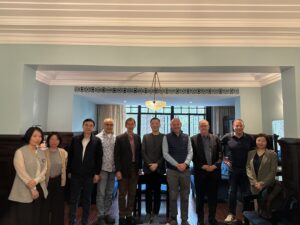
The Asia Optometric Management Academy hosted a lunch for conference sponsors and attending and presenting key opinion leaders.
Prof. Langis Michaud, author of the book, “Managing Myopia One Child at a Time,” presented “Why and How to Improve Myopia Control Efficacy,” suggesting a diagnostic approach and a decision tree that accounts for the variation among patients. The result is an approach tailored to the individual patient; one recipe does not fit all. After exploring benefits and limitations of various treatment strategies, he concluded that myopia control should be standard practice but should account for the individual characteristics of each patient. “We have to understand where myopia is coming from,” he said to launch his presentation.
Dr. Thomas Aller, discussing “Managing Progressive Myopia at All Ages to Reduce Future Vision Impairment,” explained that to prevent massive amounts of vision impairment in the future, we must treat the very young in the pre-myopia stage, treat aggressively the child and adolescent with the most effective treatments for that child, and develop treatments to protect adults and older adults already showing signs of myopia-related pathology and at risk for myopic maculopathy against vision loss.
Questioning Why Myopia Development is Still Misunderstood
Presenting remotely from Germany, Prof. Frank Schaeffel, covered “Functional Changes in the Myopic Retina Compromise Emmetropization,” posing three unresolved basic questions:
- If emmetropization guides eye growth as a closed loop feedback system, as shown in many animal studies, why does it give up in myopia?
- Why does undercorrection not work even though it is comparable to wearing a positive lens that inhibits eye growth in animal models?
- Why are almost all current treatment efforts only partially effective, basically showing that the mechanism is not fully understood?
Prof. Schaeffel then suggested that these questions can be answered if we assume that emmetropization is deficient in myopes, explaining that there are several experiments showing that the myopic retina presents some subtle functional deficiencies that are not affecting vision. After presenting examples from studies in young human subjects, he posed two further questions:
- When do these changes occur?
- Are they the result or the consequence of myopia development?
In his presentation on “Consistency of Axial Length Treatment Effect Over Time,” Prof. Fabian Conrad of Australia shared his following conclusions:
- Myopia is a significant public health challenge all over the world, and a large scientific effort is underway to research solutions to slow the progression of myopia in children.
- All published RCTs of intervention vs. control report significant efficacy, however, the reported magnitude of control, or efficacy, varies significantly.
- When looking at individual time periods within the same study, efficacy varies significantly.
- Most peer-reviewed clinical trials report better efficacy in the first observation period compared to the last observation period.
- Often the first observation period is the most successful.
Result from the Longest Study of a Myopia Treatment
The day’s sessions were concluded with Paul Chamberlain of CooperVision sharing seven-year results for MiSight. In conclusion, he summarized the results:
- MiSight 1 day can sustain its treatment effect over six consecutive years of treatment.
- MiSight 1 day slows eye growth to emmetropic levels.
- Successful treatment effects are different for fast and slow progressors.
- Accumulated treatment effects are retained once treatment is stopped.
Myopia Management in China
Awareness of the availability of myopia management treatments and their implementation are high in China, more prevalent than most other countries in the world. Prof. Bruce Lan Weizhong of AIER, the country’s largest private hospital group, credits this to the fact that it’s been a serious issue in China for a long time.
In China, eye care is delivered primarily through hospitals. Parents bring their children on weekends (so as not to interrupt their education on weekdays) and wait in packed facilities for their approximately four minutes with the ophthalmologists, who can see 100 or more patients per day. (Private hospitals offer the luxury of spending more time with patients.)
Orthokeratology is the primary treatment for myopia management, along with recently approved atropine, soft contact lenses, and spectacle lenses. It’s estimated that there are more than 200 myopia management spectacle lenses available in China, evidence-based designs from the major international manufacturers as well as a host of “inspired-by” others from domestic producers.
Eye care is also available through optical shops, many privatized and independently owned by Chinese entrepreneurs. However, optical shops cannot prescribe OrthoK or atropine, and while they can prescribe contact lenses to correct myopia, they cannot prescribe those designated to slow its progression.

Prof. Bruce Lan Weizhong (left), Associate Director of the AIER Optometry and Vision Institute, this year’s sponsor of the International Myopia Conference, with John Sailer, the Editor-in-Chief of Review of Myopia Management, the Official Media Sponsor of IMC.
A Distant Mirror
Privatization is a trend in China, at least among optical shops, according to Tan Kah Ooi of AOMA. Much like the United States, these private optical shop owners are facing competition, especially from online retailers. Helping them compete is one of the goals of AOMA, which is teaching by example by bringing shop owners from other Southeast Asian countries that have already gone through the process of incorporating specialties such as myopia management into their practices.
Among the global KOLs presenting at “Frontier in Vision Science Summit – Myopia Research” were:
- Prof. Tan Kah Ooi, Singapore, host on behalf of Asian Optometric Management A(gency)
- Prof. Serge Resnikoff, France, Global Myopia Burden
- Prof. Langis Michaud, Canada, Myopia Management: How to Optimize Results
- Dr. Thomas Aller, USA, “Managing Progressive Myopia At All Ages to Reduce Future Vision Impairment”
- Ron Beerten, The Netherlands, CONTROL Study (partner-sponsored session)
- Prof. Frank Schaeffel, Germany, “Functional Changes in the Myopic Retina Compromise Emmetropization”
- Prof. Maria Liu, USA, “Common Misconception in Axial Growth and Myopia Development”
- Prof. Fabian Conrad, Australia, “Consistency of Axial Length Treatment Effect Over Time”
- Paul Chamberlain, USA, “Lessons Learned from Seven-Year Trial of a Myopia Control Contact Lens”
Chinese KOLs were:
- Prof. Zhou Xingtao, Shanghai, host on behalf of EENT Fudan University and presenting on “Review and Outlook of 20 Years of Refractive Surgery in China”
- Prof. Li Lihua, Tianjin, China, “Machine Learning Models for Orthokeratology Lens Fitting and Axial Length Prediction”
- Prof. Peter Chen, Shanghai, “Effect of Different OrthoK Lens Designs on Corneal Profile and Myopia Control Efficacy”
- Prof. Bruce Lan Weizhong, Changsha, China, “IMI Global Trends in Myopia Management Attitudes and Strategies in Clinical Practice Update”
- Prof. Lam Chuen, HKSAR, China, “Exploring Molecular Mechanism of Atropine in Myopia Control—Insight from Retinal Proteome Analysis”
- Prof. Wei Wenbin, Beijing, “The Related Mechanisms of RPE Cells Involved in the Occurrence and Development of Myopia”
- Prof. Wei Ruihua, Tianjin, China, “Latest Research on Repeated Low-Level Red-Light Therapy on Myopia Control – Efficacy and Safety”
- Prof. Wang Kai, Beijing, “Learning from BOZD 6.00 mm to 5.00 mm – Best Indicator Predicting Myopia Progression”
- Prof. Yang Xiao, Guangzhou, China, “Axial Shortening – A Big Data Analysis”
Exclusive Videos from the Event
Review of Myopia Management’s Editor-in-Chief John Sailer interviewed several of the international leaders in the myopia space at the conference. See their thoughts here:
Prof. Tan Kah Ooi
Paul Chamberlain, CooperVision
Arthur Kung, CooperVision
Prof. Langis Michaud
A Look into the Event
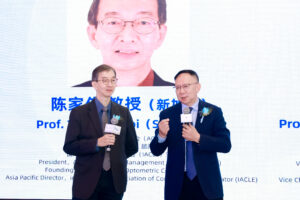
AOMA’s Tan Kah Ooi (left) and AIER Eye Group’s Prof. Yang Zhikuan welcomed attendees to the “Frontier in Vision Science Summit – Myopia Research.”
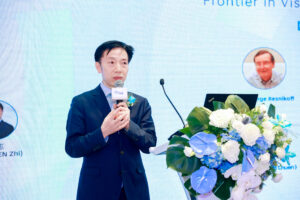
Representing event co-organizer, Fudan University Eye and ENT Hospital Prof. Zhou Xingtao also welcomed attendees.
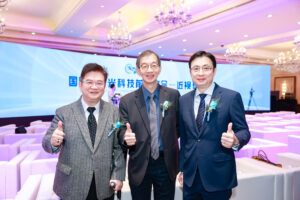
(From left) AOMA’s Eddie Wong, Tan Kah Ooi, and Dicky Ye Zhoufeng signal their approval at the start of the Myopia Research Summit.

The event filled a room at the Intercontinental Hotel in Shanghai with international and local key opinion leaders along with many of China’s leading ophthalmologists.
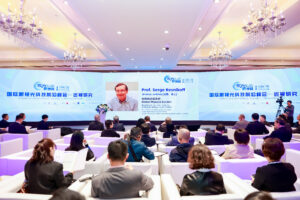
Prof. Serge Resnikoff, Chair of the International Myopia Institute, remotely presented “Global Myopia Burden,” citing statistics supporting the urgent need to slow the progression of myopia.
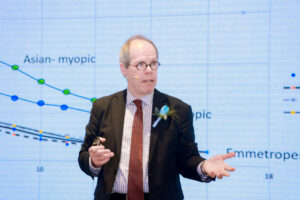
Prof. Langis Michaud attended from the Université de Montréal to present “Myopia Management: How to Optimize Results.”
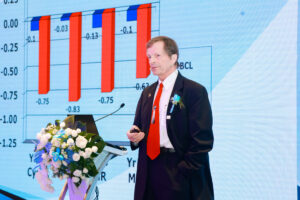
Dr. Thomas Aller from the United States presented “Managing Progressive Myopia at All Ages to Reduce Future Vision Impairment.”

Orthokeratology was covered by Prof. Peter Chen of Shanghai in “Effect of Different OrthoK Designs on Corneal Profile and Myopia Control Efficacy.”
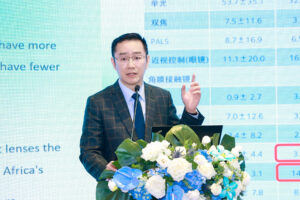
Prof. Bruce Lan Wei Zhong of AEIR Eye Group shared the IMI’s “Global Trends in Myopia Management Attitudes and Strategies in Clinical Practice Update.”
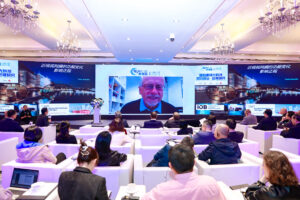
Remotely presenting from Germany, Prof. Frank Schaeffel covered “Functional Changes in the Myopic Retina Compromize Emmetropization.”
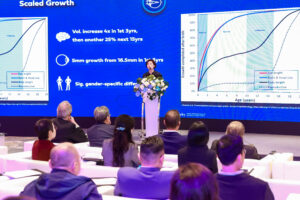
Prof. Maria Liu of UC Berkeley attended from the United States to present “Common Misconceptions in Axial Growth and Myopia Development.”
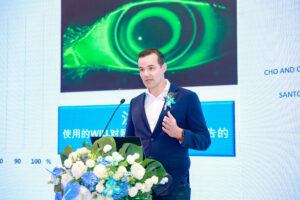
From the University of New South Wales Australia, Dr. Fabian Conrad covered “Consistency of Axial Length Treatment Effect Over Time.”
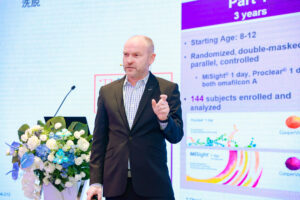
CooperVision’s Paul Chamberlain from the United States presented “Lessons Learned from a 7-year Trial of a Myopia Control Contact Lens.”


